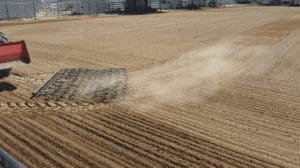Prevention is the best way to deal with horse respiratory problems caused by dust. That’s why it’s better to stay informed and do your part to protect your horse’s health from the hazardous effects of dust.
But how exactly are you going to prevent respiratory issues from occurring and affecting your horse’s respiratory system?
Read on to find out what to do to minimize dust in all the areas of your horse’s life, from the barn to the arena and on the means of transportation.
Implementing these tips will help you protect your horse’s lungs so that it can lead a long and happy, healthy life.
The horse respiratory system
But first, let’s see how and why dust affects the horse’s respiratory system. A horse takes about 12 breaths every minute in a state of rest, inhaling up to 60 liters of air. A performance horse in motion can reach an incredible 150 breaths every minute, inhaling over 2,250 liters of air.
Now that’s a lot of air, so you can see how it could be problematic if it’s polluted or infected with dust.
Here’s how the horse respiratory system works: air enters the horse’s lungs through the nostrils and the trachea. Next, the air is transported along large airways and small airways until the gas exchange occurs in the alveolar sacs. Here, the inhaled particles of dust or bacteria are cleaned and filtered by cells called macrophages.
But, if the dust quantity increases and the exposure is prolonged, it can affect the cells’ ability to fight infections and bacteria.
That’s why it’s critical to reduce dust exposure as much as we can. Next, we’re going to uncover a few ways to do that.
Dust Control Tips In The Barn
In the barn, dust seems to be all over the place. But it’s not just unpleasant; it can be dangerous to some horses.
See the tips below to find out how to avoid dust exposure in the barn so you can keep your horses healthy.
Ventilate often
Ventilation is a critical component of dust management. It’s important to keep windows open as much as possible and supplement with fans if natural ventilation is not sufficient.
Use low dust bedding
Clean, dust free bedding with absorbent properties will significantly help reduce the dust-levels in the barn. Unprocessed straw bales are not ideal bedding from this perspective, as the levels of dust are often high. Consider using other low-dust bedding alternatives such as peat, dust-extracted wood shavings, or paper bed. Another option is dust-extracted straw bedding, which is specially designed for high absorption.

Collect manure
Cleaning often is a must in the barn, not only for aesthetic reasons but also for health reasons. Manure can quickly turn to dust if not cleaned properly, so make sure you invest some time cleaning the place.
Feed quality food
Always make sure you feed quality hay and grain since the low-quality hay can be dusty and moldy.
Also, store hay in a separate building from the horses to avoid the contamination with fungal spores when hay nets are filled.
Arena Dust Control
In the arena, the danger is even more significant than in the barn since the horse is in motion and, if the arena is dusty, it will inhale a more considerable amount of dust.
If a horse has to compete or perform with his airways blocked by mucus caused by dust, this can affect his health. Let’s see what you can do to keep your arena dust-free and provide a healthy training ground for your horse.
Water often
Water can help prevent dust from rising and ensure clean air in the arena. Make sure you often water, especially on hot summer days.
Use a dust-free arena footing
If possible and available, you should consider investing in low-dust footing options such as wood or rubber. They can significantly reduce the amount of dust and improve air quality.
Use WHOA Dust®
A great way to remove dust without watering all the time or spend too much is WHOA Dust®. It’s designed to keep the dust down, reduce the frequency and amount of water needed, and it improves the quality of your arena footing. It’s also safe for animals, humans and the environment and can be used on indoor or outdoor arenas.
Transportation Dust Control
You might have never thought about this, but you should protect your horse from dust even on the road. When traveling, a horse can be exposed to increased dust quantities due to wind, traffic, and weather conditions. Straw shavings can quickly become dusty and hazardous. Always add slight moisture to the bedding on your trailer to prevent the dust from rising during the trip.
Use rubber stall mats
Using rubber stall mats is a great alternative to protect your horse’s legs while minimizing dust pollution.
Keep the trailer well-ventilated
In the trailer, just like in the barn, ventilation is essential to keep dust at bay.
Final thoughts
Dust can be hazardous, and it can be found almost everywhere. But it’s up to us to make sure it doesn’t reach the levels where it can affect the horse’s health or performance. Keep an eye on our blog for more dust-management tips, and contact us if you need more guidance.







